Finance Exam: Profitability, Breakeven Analysis, and Variance Analysis
VerifiedAdded on 2022/12/15
|7
|1657
|323
Homework Assignment
AI Summary
This document provides a comprehensive analysis of a finance exam, addressing key financial concepts and calculations. The exam solution includes detailed calculations of gross profit, net profit, and related ratios, along with an assessment of declining profitability and cash flow problems. It also explores breakeven analysis, including calculation and advantages, and delves into activity-based costing. Furthermore, the document analyzes significant variances between budgeted and actual data, identifying causes, consequences, and strategies for variance elimination. The solution also discusses zero-based budgeting. The assignment aims to provide a clear understanding of financial analysis, variance analysis, and budgeting techniques, offering practical recommendations for improving operational efficiency and financial performance. This assignment is contributed by a student to be published on the website Desklib, a platform which provides all the necessary AI based study tools for students.

ONLINE FINANCE EXAM
Paraphrase This Document
Need a fresh take? Get an instant paraphrase of this document with our AI Paraphraser
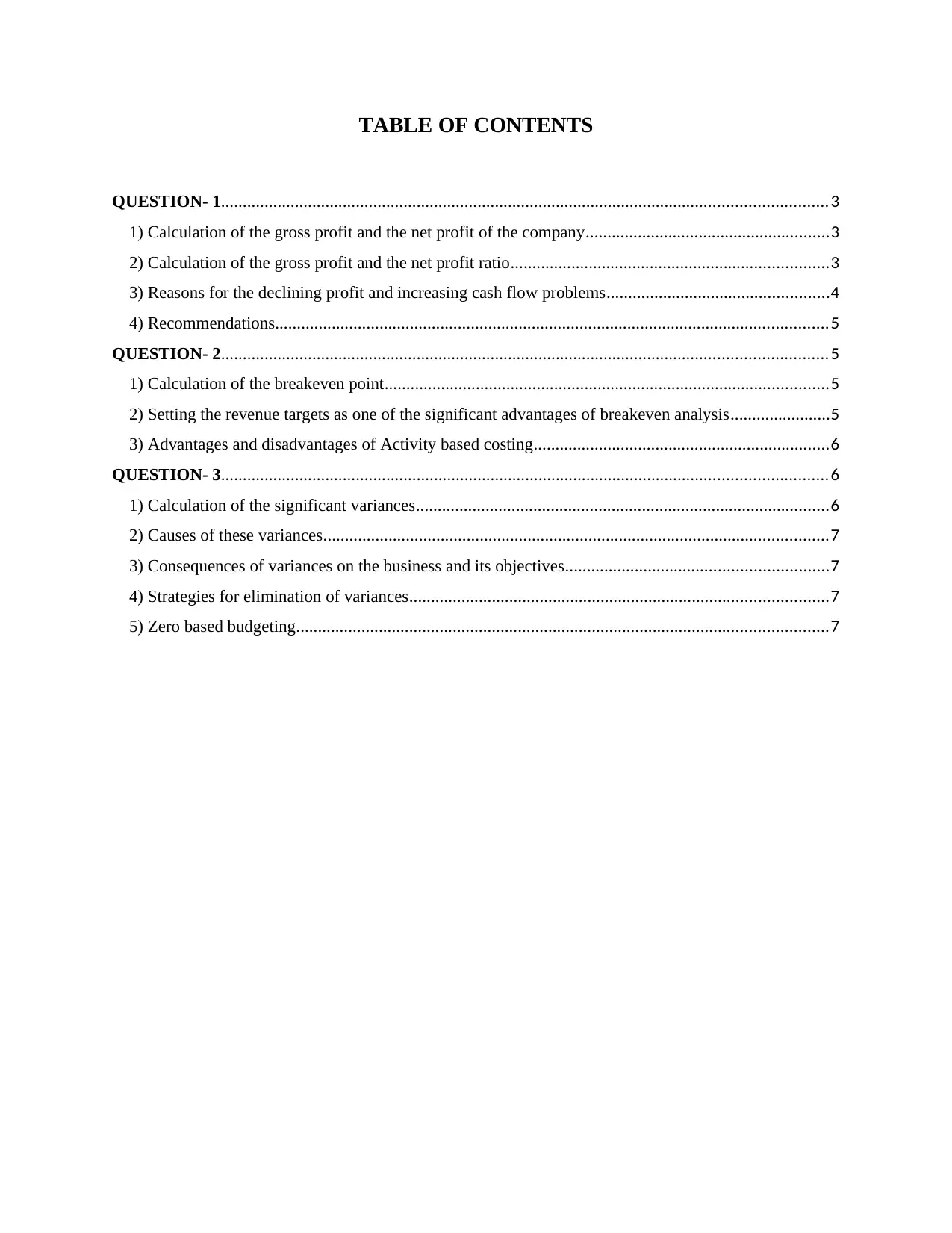
TABLE OF CONTENTS
QUESTION- 1...........................................................................................................................................3
1) Calculation of the gross profit and the net profit of the company........................................................3
2) Calculation of the gross profit and the net profit ratio.........................................................................3
3) Reasons for the declining profit and increasing cash flow problems...................................................4
4) Recommendations...............................................................................................................................5
QUESTION- 2...........................................................................................................................................5
1) Calculation of the breakeven point......................................................................................................5
2) Setting the revenue targets as one of the significant advantages of breakeven analysis.......................5
3) Advantages and disadvantages of Activity based costing....................................................................6
QUESTION- 3...........................................................................................................................................6
1) Calculation of the significant variances...............................................................................................6
2) Causes of these variances....................................................................................................................7
3) Consequences of variances on the business and its objectives............................................................7
4) Strategies for elimination of variances................................................................................................7
5) Zero based budgeting..........................................................................................................................7
QUESTION- 1...........................................................................................................................................3
1) Calculation of the gross profit and the net profit of the company........................................................3
2) Calculation of the gross profit and the net profit ratio.........................................................................3
3) Reasons for the declining profit and increasing cash flow problems...................................................4
4) Recommendations...............................................................................................................................5
QUESTION- 2...........................................................................................................................................5
1) Calculation of the breakeven point......................................................................................................5
2) Setting the revenue targets as one of the significant advantages of breakeven analysis.......................5
3) Advantages and disadvantages of Activity based costing....................................................................6
QUESTION- 3...........................................................................................................................................6
1) Calculation of the significant variances...............................................................................................6
2) Causes of these variances....................................................................................................................7
3) Consequences of variances on the business and its objectives............................................................7
4) Strategies for elimination of variances................................................................................................7
5) Zero based budgeting..........................................................................................................................7
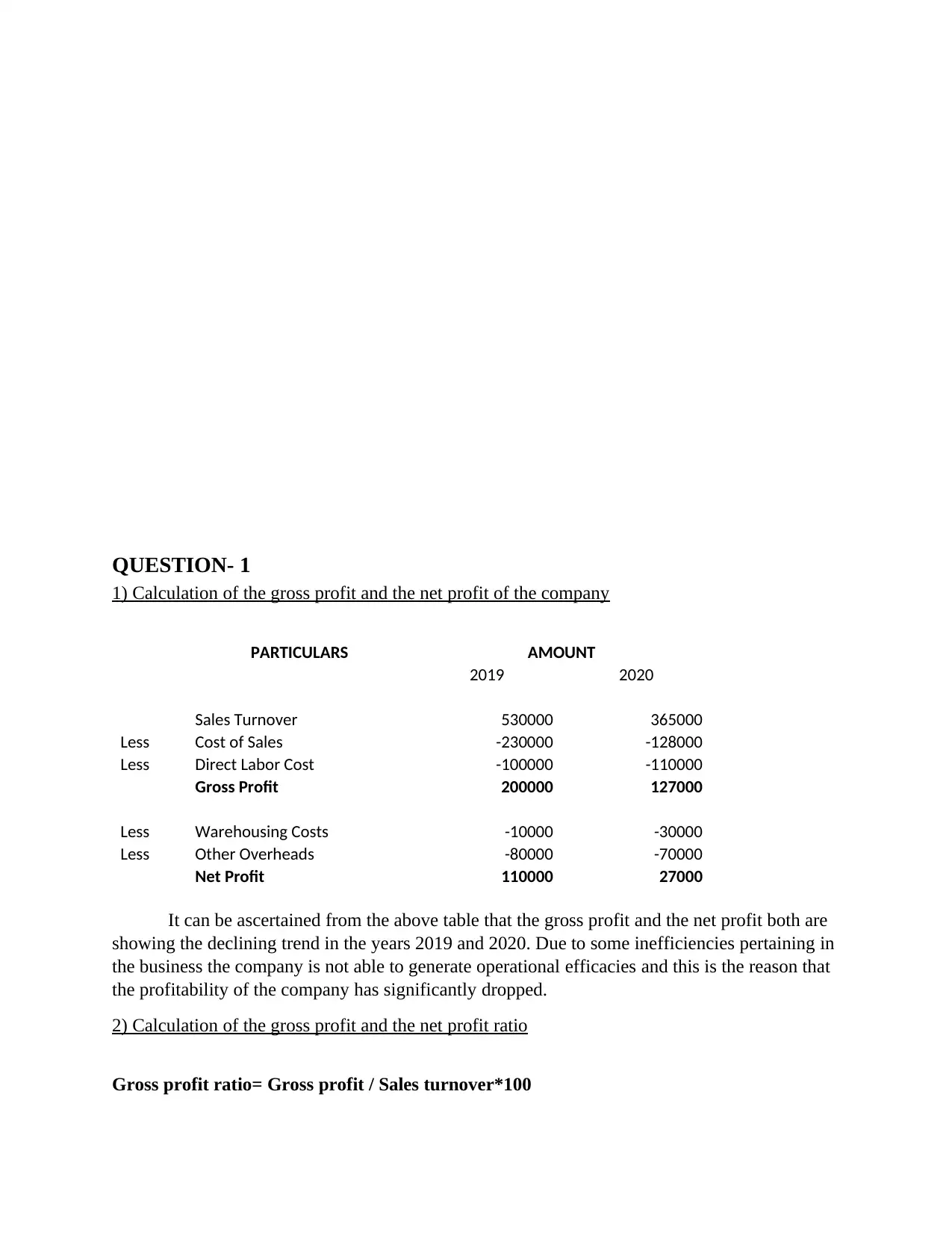
QUESTION- 1
1) Calculation of the gross profit and the net profit of the company
PARTICULARS AMOUNT
2019 2020
Sales Turnover 530000 365000
Less Cost of Sales -230000 -128000
Less Direct Labor Cost -100000 -110000
Gross Profit 200000 127000
Less Warehousing Costs -10000 -30000
Less Other Overheads -80000 -70000
Net Profit 110000 27000
It can be ascertained from the above table that the gross profit and the net profit both are
showing the declining trend in the years 2019 and 2020. Due to some inefficiencies pertaining in
the business the company is not able to generate operational efficacies and this is the reason that
the profitability of the company has significantly dropped.
2) Calculation of the gross profit and the net profit ratio
Gross profit ratio= Gross profit / Sales turnover*100
1) Calculation of the gross profit and the net profit of the company
PARTICULARS AMOUNT
2019 2020
Sales Turnover 530000 365000
Less Cost of Sales -230000 -128000
Less Direct Labor Cost -100000 -110000
Gross Profit 200000 127000
Less Warehousing Costs -10000 -30000
Less Other Overheads -80000 -70000
Net Profit 110000 27000
It can be ascertained from the above table that the gross profit and the net profit both are
showing the declining trend in the years 2019 and 2020. Due to some inefficiencies pertaining in
the business the company is not able to generate operational efficacies and this is the reason that
the profitability of the company has significantly dropped.
2) Calculation of the gross profit and the net profit ratio
Gross profit ratio= Gross profit / Sales turnover*100
⊘ This is a preview!⊘
Do you want full access?
Subscribe today to unlock all pages.

Trusted by 1+ million students worldwide
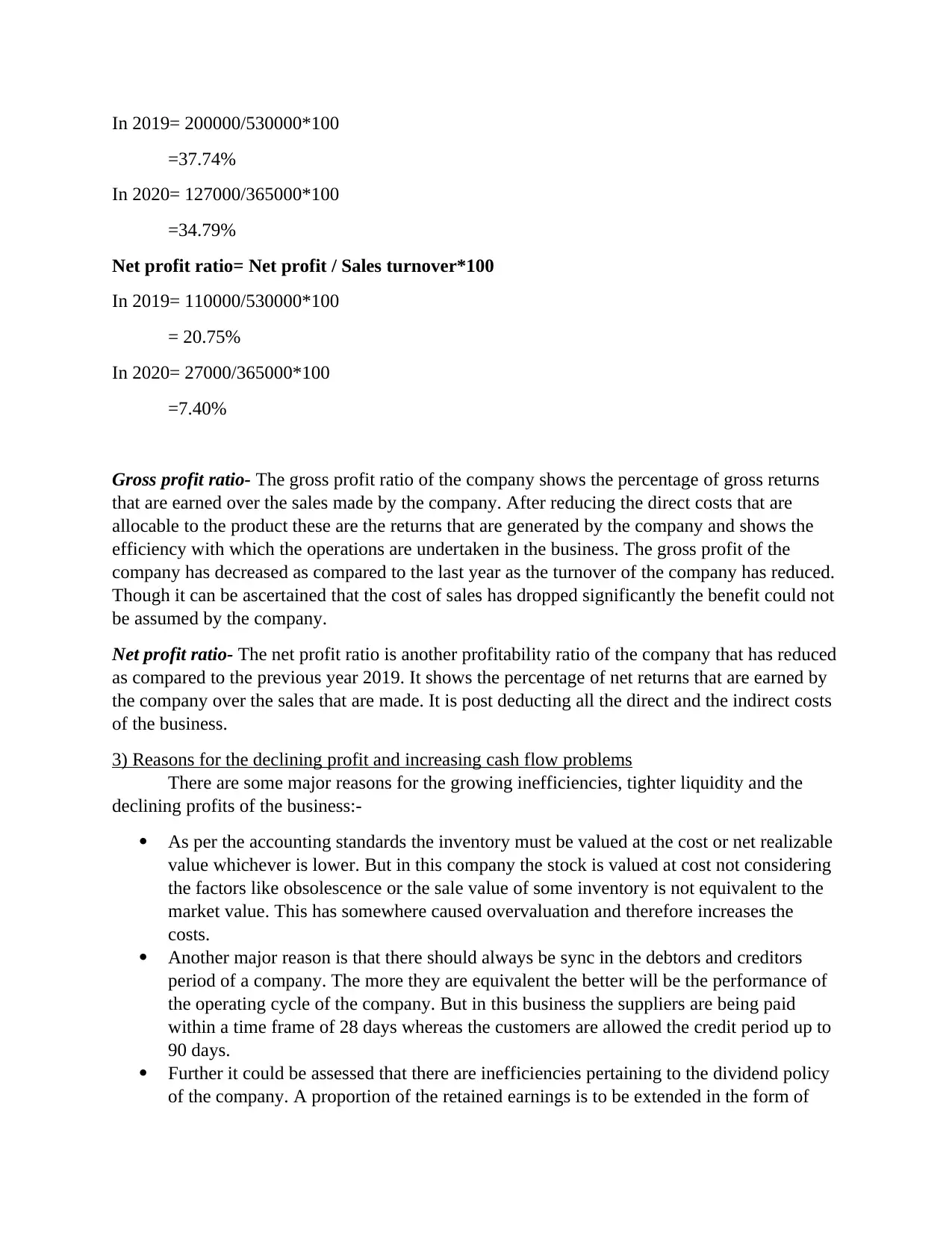
In 2019= 200000/530000*100
=37.74%
In 2020= 127000/365000*100
=34.79%
Net profit ratio= Net profit / Sales turnover*100
In 2019= 110000/530000*100
= 20.75%
In 2020= 27000/365000*100
=7.40%
Gross profit ratio- The gross profit ratio of the company shows the percentage of gross returns
that are earned over the sales made by the company. After reducing the direct costs that are
allocable to the product these are the returns that are generated by the company and shows the
efficiency with which the operations are undertaken in the business. The gross profit of the
company has decreased as compared to the last year as the turnover of the company has reduced.
Though it can be ascertained that the cost of sales has dropped significantly the benefit could not
be assumed by the company.
Net profit ratio- The net profit ratio is another profitability ratio of the company that has reduced
as compared to the previous year 2019. It shows the percentage of net returns that are earned by
the company over the sales that are made. It is post deducting all the direct and the indirect costs
of the business.
3) Reasons for the declining profit and increasing cash flow problems
There are some major reasons for the growing inefficiencies, tighter liquidity and the
declining profits of the business:-
As per the accounting standards the inventory must be valued at the cost or net realizable
value whichever is lower. But in this company the stock is valued at cost not considering
the factors like obsolescence or the sale value of some inventory is not equivalent to the
market value. This has somewhere caused overvaluation and therefore increases the
costs.
Another major reason is that there should always be sync in the debtors and creditors
period of a company. The more they are equivalent the better will be the performance of
the operating cycle of the company. But in this business the suppliers are being paid
within a time frame of 28 days whereas the customers are allowed the credit period up to
90 days.
Further it could be assessed that there are inefficiencies pertaining to the dividend policy
of the company. A proportion of the retained earnings is to be extended in the form of
=37.74%
In 2020= 127000/365000*100
=34.79%
Net profit ratio= Net profit / Sales turnover*100
In 2019= 110000/530000*100
= 20.75%
In 2020= 27000/365000*100
=7.40%
Gross profit ratio- The gross profit ratio of the company shows the percentage of gross returns
that are earned over the sales made by the company. After reducing the direct costs that are
allocable to the product these are the returns that are generated by the company and shows the
efficiency with which the operations are undertaken in the business. The gross profit of the
company has decreased as compared to the last year as the turnover of the company has reduced.
Though it can be ascertained that the cost of sales has dropped significantly the benefit could not
be assumed by the company.
Net profit ratio- The net profit ratio is another profitability ratio of the company that has reduced
as compared to the previous year 2019. It shows the percentage of net returns that are earned by
the company over the sales that are made. It is post deducting all the direct and the indirect costs
of the business.
3) Reasons for the declining profit and increasing cash flow problems
There are some major reasons for the growing inefficiencies, tighter liquidity and the
declining profits of the business:-
As per the accounting standards the inventory must be valued at the cost or net realizable
value whichever is lower. But in this company the stock is valued at cost not considering
the factors like obsolescence or the sale value of some inventory is not equivalent to the
market value. This has somewhere caused overvaluation and therefore increases the
costs.
Another major reason is that there should always be sync in the debtors and creditors
period of a company. The more they are equivalent the better will be the performance of
the operating cycle of the company. But in this business the suppliers are being paid
within a time frame of 28 days whereas the customers are allowed the credit period up to
90 days.
Further it could be assessed that there are inefficiencies pertaining to the dividend policy
of the company. A proportion of the retained earnings is to be extended in the form of
Paraphrase This Document
Need a fresh take? Get an instant paraphrase of this document with our AI Paraphraser
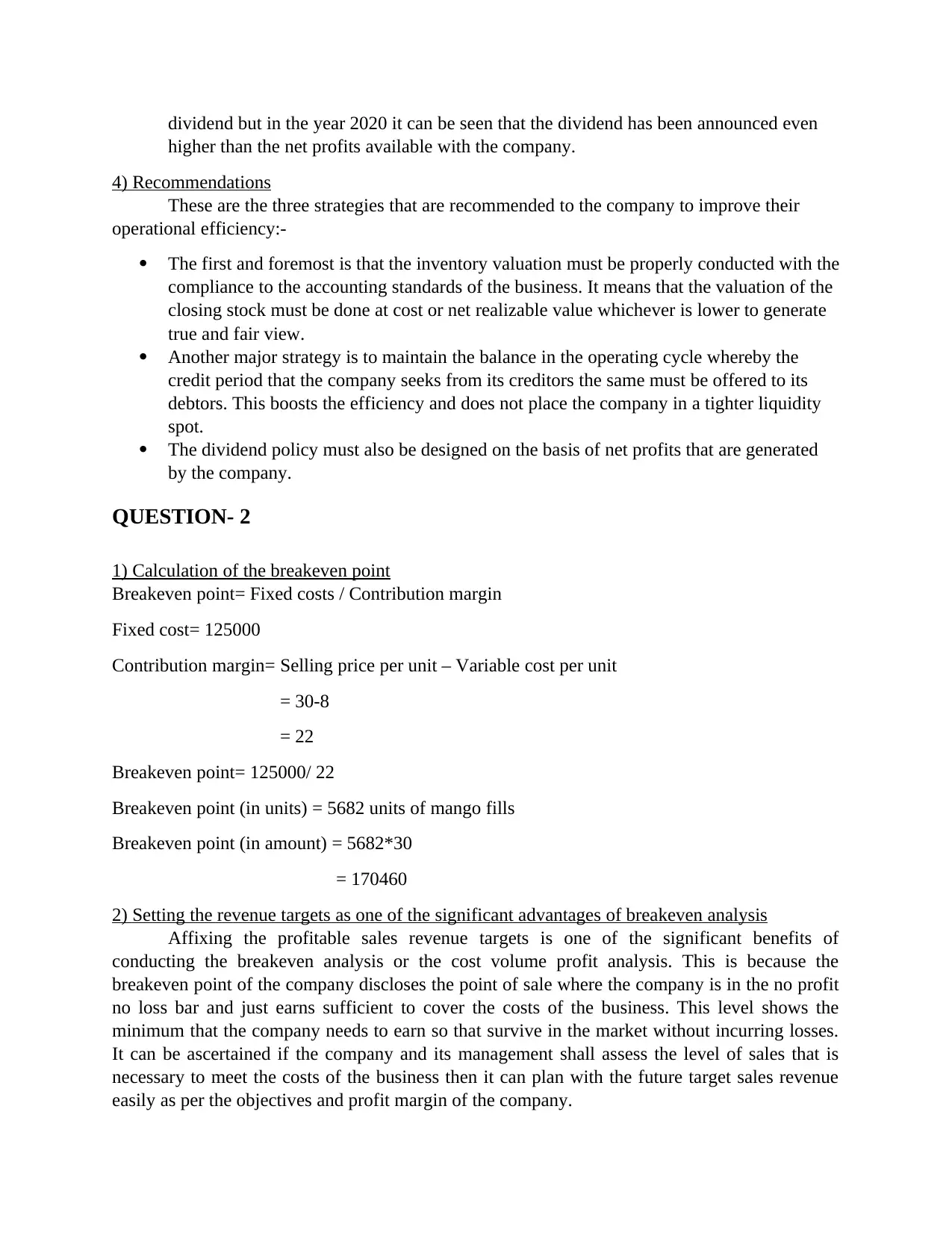
dividend but in the year 2020 it can be seen that the dividend has been announced even
higher than the net profits available with the company.
4) Recommendations
These are the three strategies that are recommended to the company to improve their
operational efficiency:-
The first and foremost is that the inventory valuation must be properly conducted with the
compliance to the accounting standards of the business. It means that the valuation of the
closing stock must be done at cost or net realizable value whichever is lower to generate
true and fair view.
Another major strategy is to maintain the balance in the operating cycle whereby the
credit period that the company seeks from its creditors the same must be offered to its
debtors. This boosts the efficiency and does not place the company in a tighter liquidity
spot.
The dividend policy must also be designed on the basis of net profits that are generated
by the company.
QUESTION- 2
1) Calculation of the breakeven point
Breakeven point= Fixed costs / Contribution margin
Fixed cost= 125000
Contribution margin= Selling price per unit – Variable cost per unit
= 30-8
= 22
Breakeven point= 125000/ 22
Breakeven point (in units) = 5682 units of mango fills
Breakeven point (in amount) = 5682*30
= 170460
2) Setting the revenue targets as one of the significant advantages of breakeven analysis
Affixing the profitable sales revenue targets is one of the significant benefits of
conducting the breakeven analysis or the cost volume profit analysis. This is because the
breakeven point of the company discloses the point of sale where the company is in the no profit
no loss bar and just earns sufficient to cover the costs of the business. This level shows the
minimum that the company needs to earn so that survive in the market without incurring losses.
It can be ascertained if the company and its management shall assess the level of sales that is
necessary to meet the costs of the business then it can plan with the future target sales revenue
easily as per the objectives and profit margin of the company.
higher than the net profits available with the company.
4) Recommendations
These are the three strategies that are recommended to the company to improve their
operational efficiency:-
The first and foremost is that the inventory valuation must be properly conducted with the
compliance to the accounting standards of the business. It means that the valuation of the
closing stock must be done at cost or net realizable value whichever is lower to generate
true and fair view.
Another major strategy is to maintain the balance in the operating cycle whereby the
credit period that the company seeks from its creditors the same must be offered to its
debtors. This boosts the efficiency and does not place the company in a tighter liquidity
spot.
The dividend policy must also be designed on the basis of net profits that are generated
by the company.
QUESTION- 2
1) Calculation of the breakeven point
Breakeven point= Fixed costs / Contribution margin
Fixed cost= 125000
Contribution margin= Selling price per unit – Variable cost per unit
= 30-8
= 22
Breakeven point= 125000/ 22
Breakeven point (in units) = 5682 units of mango fills
Breakeven point (in amount) = 5682*30
= 170460
2) Setting the revenue targets as one of the significant advantages of breakeven analysis
Affixing the profitable sales revenue targets is one of the significant benefits of
conducting the breakeven analysis or the cost volume profit analysis. This is because the
breakeven point of the company discloses the point of sale where the company is in the no profit
no loss bar and just earns sufficient to cover the costs of the business. This level shows the
minimum that the company needs to earn so that survive in the market without incurring losses.
It can be ascertained if the company and its management shall assess the level of sales that is
necessary to meet the costs of the business then it can plan with the future target sales revenue
easily as per the objectives and profit margin of the company.
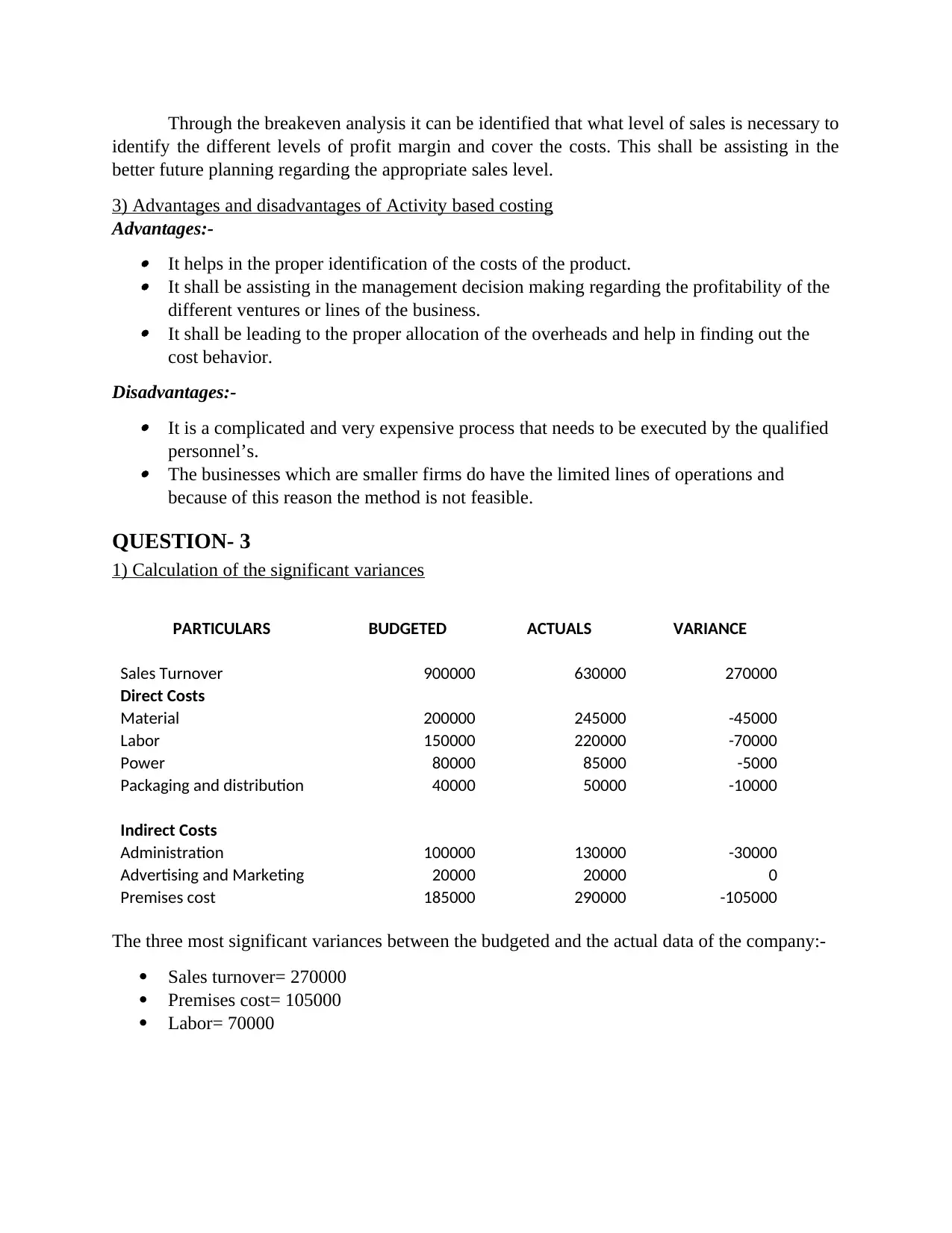
Through the breakeven analysis it can be identified that what level of sales is necessary to
identify the different levels of profit margin and cover the costs. This shall be assisting in the
better future planning regarding the appropriate sales level.
3) Advantages and disadvantages of Activity based costing
Advantages:- It helps in the proper identification of the costs of the product.
It shall be assisting in the management decision making regarding the profitability of the
different ventures or lines of the business.
It shall be leading to the proper allocation of the overheads and help in finding out the
cost behavior.
Disadvantages:- It is a complicated and very expensive process that needs to be executed by the qualified
personnel’s.
The businesses which are smaller firms do have the limited lines of operations and
because of this reason the method is not feasible.
QUESTION- 3
1) Calculation of the significant variances
PARTICULARS BUDGETED ACTUALS VARIANCE
Sales Turnover 900000 630000 270000
Direct Costs
Material 200000 245000 -45000
Labor 150000 220000 -70000
Power 80000 85000 -5000
Packaging and distribution 40000 50000 -10000
Indirect Costs
Administration 100000 130000 -30000
Advertising and Marketing 20000 20000 0
Premises cost 185000 290000 -105000
The three most significant variances between the budgeted and the actual data of the company:-
Sales turnover= 270000
Premises cost= 105000
Labor= 70000
identify the different levels of profit margin and cover the costs. This shall be assisting in the
better future planning regarding the appropriate sales level.
3) Advantages and disadvantages of Activity based costing
Advantages:- It helps in the proper identification of the costs of the product.
It shall be assisting in the management decision making regarding the profitability of the
different ventures or lines of the business.
It shall be leading to the proper allocation of the overheads and help in finding out the
cost behavior.
Disadvantages:- It is a complicated and very expensive process that needs to be executed by the qualified
personnel’s.
The businesses which are smaller firms do have the limited lines of operations and
because of this reason the method is not feasible.
QUESTION- 3
1) Calculation of the significant variances
PARTICULARS BUDGETED ACTUALS VARIANCE
Sales Turnover 900000 630000 270000
Direct Costs
Material 200000 245000 -45000
Labor 150000 220000 -70000
Power 80000 85000 -5000
Packaging and distribution 40000 50000 -10000
Indirect Costs
Administration 100000 130000 -30000
Advertising and Marketing 20000 20000 0
Premises cost 185000 290000 -105000
The three most significant variances between the budgeted and the actual data of the company:-
Sales turnover= 270000
Premises cost= 105000
Labor= 70000
⊘ This is a preview!⊘
Do you want full access?
Subscribe today to unlock all pages.

Trusted by 1+ million students worldwide
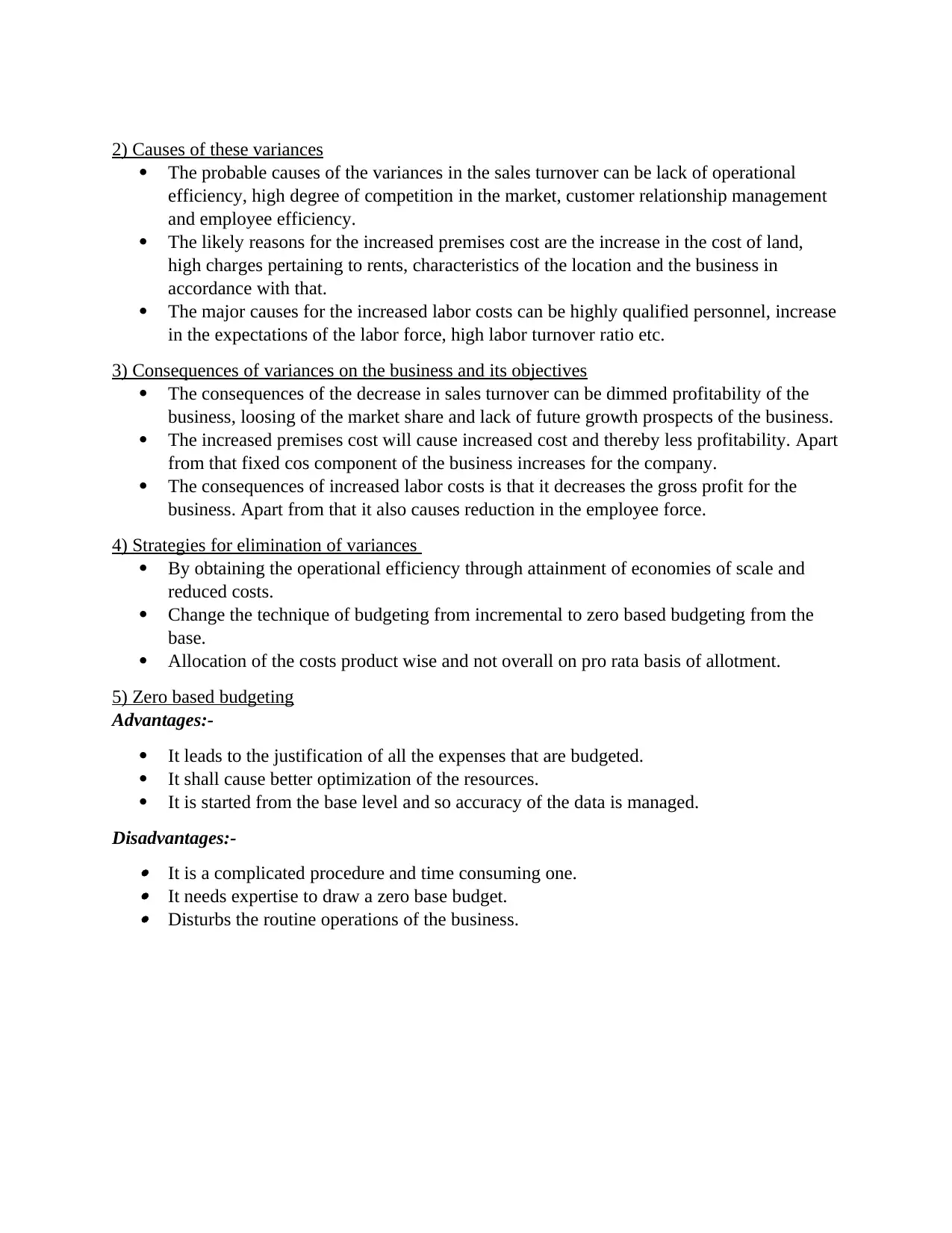
2) Causes of these variances
The probable causes of the variances in the sales turnover can be lack of operational
efficiency, high degree of competition in the market, customer relationship management
and employee efficiency.
The likely reasons for the increased premises cost are the increase in the cost of land,
high charges pertaining to rents, characteristics of the location and the business in
accordance with that.
The major causes for the increased labor costs can be highly qualified personnel, increase
in the expectations of the labor force, high labor turnover ratio etc.
3) Consequences of variances on the business and its objectives
The consequences of the decrease in sales turnover can be dimmed profitability of the
business, loosing of the market share and lack of future growth prospects of the business.
The increased premises cost will cause increased cost and thereby less profitability. Apart
from that fixed cos component of the business increases for the company.
The consequences of increased labor costs is that it decreases the gross profit for the
business. Apart from that it also causes reduction in the employee force.
4) Strategies for elimination of variances
By obtaining the operational efficiency through attainment of economies of scale and
reduced costs.
Change the technique of budgeting from incremental to zero based budgeting from the
base.
Allocation of the costs product wise and not overall on pro rata basis of allotment.
5) Zero based budgeting
Advantages:-
It leads to the justification of all the expenses that are budgeted.
It shall cause better optimization of the resources.
It is started from the base level and so accuracy of the data is managed.
Disadvantages:- It is a complicated procedure and time consuming one.
It needs expertise to draw a zero base budget.
Disturbs the routine operations of the business.
The probable causes of the variances in the sales turnover can be lack of operational
efficiency, high degree of competition in the market, customer relationship management
and employee efficiency.
The likely reasons for the increased premises cost are the increase in the cost of land,
high charges pertaining to rents, characteristics of the location and the business in
accordance with that.
The major causes for the increased labor costs can be highly qualified personnel, increase
in the expectations of the labor force, high labor turnover ratio etc.
3) Consequences of variances on the business and its objectives
The consequences of the decrease in sales turnover can be dimmed profitability of the
business, loosing of the market share and lack of future growth prospects of the business.
The increased premises cost will cause increased cost and thereby less profitability. Apart
from that fixed cos component of the business increases for the company.
The consequences of increased labor costs is that it decreases the gross profit for the
business. Apart from that it also causes reduction in the employee force.
4) Strategies for elimination of variances
By obtaining the operational efficiency through attainment of economies of scale and
reduced costs.
Change the technique of budgeting from incremental to zero based budgeting from the
base.
Allocation of the costs product wise and not overall on pro rata basis of allotment.
5) Zero based budgeting
Advantages:-
It leads to the justification of all the expenses that are budgeted.
It shall cause better optimization of the resources.
It is started from the base level and so accuracy of the data is managed.
Disadvantages:- It is a complicated procedure and time consuming one.
It needs expertise to draw a zero base budget.
Disturbs the routine operations of the business.
1 out of 7
Related Documents
Your All-in-One AI-Powered Toolkit for Academic Success.
+13062052269
info@desklib.com
Available 24*7 on WhatsApp / Email
![[object Object]](/_next/static/media/star-bottom.7253800d.svg)
Unlock your academic potential
Copyright © 2020–2025 A2Z Services. All Rights Reserved. Developed and managed by ZUCOL.



